Screwdrivers come in many shapes and sizes. Wikipedia lists some 42 different types of screwdriver tips—from the common to the almost unheard-of. Here we will look at four of the most common types—flat-blade, Phillips, Allen and Torx. These are all types that most airplane people have used or at least heard of. Let’s see which type is best suited for various tasks and how to use them.
Flat-Blade Screwdrivers
The basic flat-blade screwdriver and related screws date back to the 15th century, first seen in guns of that time. They continue to be popular because they are simple and effective devices for fastening relatively small objects together. That said, they are not all that popular among airplane builders, having largely been replaced by Phillips screws and screwdrivers. Nevertheless, any good mechanic will have an assortment of sizes in their toolbox.
To get good performance out of a flat-blade screwdriver, it is important to match the blade width and thickness to the screw. Obviously, a too-large blade will not fit well into the screw slot. A too-small blade may engage the slot, but a loose fit will likely damage the slot when you tighten the screw. This is why people who make extensive use of slotted screws, such as gunsmiths, will have a large set of flat-blade screwdrivers in various widths and blade thicknesses. Most mechanics will not need to make such an investment, but an assortment of a half-dozen or so flat-blade screwdrivers will probably be necessary to do good work.
Flat-blade screwdrivers do not tolerate much misalignment. Although some tipping of the blade can be withstood, it should not be excessive. In any case, holding the screwdriver exactly in line with the axis of the screw will achieve the best results.

Phillips Screwdrivers
The Phillips screw and screwdriver were developed in the 1930s, with their first commercial appearance coming in the 1936 Cadillac. The original idea of the Phillips screw was to limit the amount of torque that could be applied to the screw. The camming action of the screw and driver would push the bit up and out of the cross-shaped slot. Oddly this is a feature that most users don’t particularly like as it tends to lead to buggered slots in the screws—however, better a buggered slot than a broken screw.
Phillips screws and drivers come in a number of sizes ranging from #000 for jewelers to #4 or #5 for very large screws that are not often seen by airplane mechanics. The most common sizes are #1 found on 4-40 machine screws, #2 fits 6-32 through 10-32 machine screws and #3 works on machine screws from #12 to ¼ inch. As you can see, if an airplane mechanic had only one Phillips screwdriver, it should be a #2. In fact, it is a good idea to have more than one of these in case one gets damaged or lost.
The Phillips head screwdriver is probably the least tolerant of misalignment of the various types of drivers. Any tipping of the tool will significantly reduce the bite in the screw slot and can easily lead to damage of the screw head.
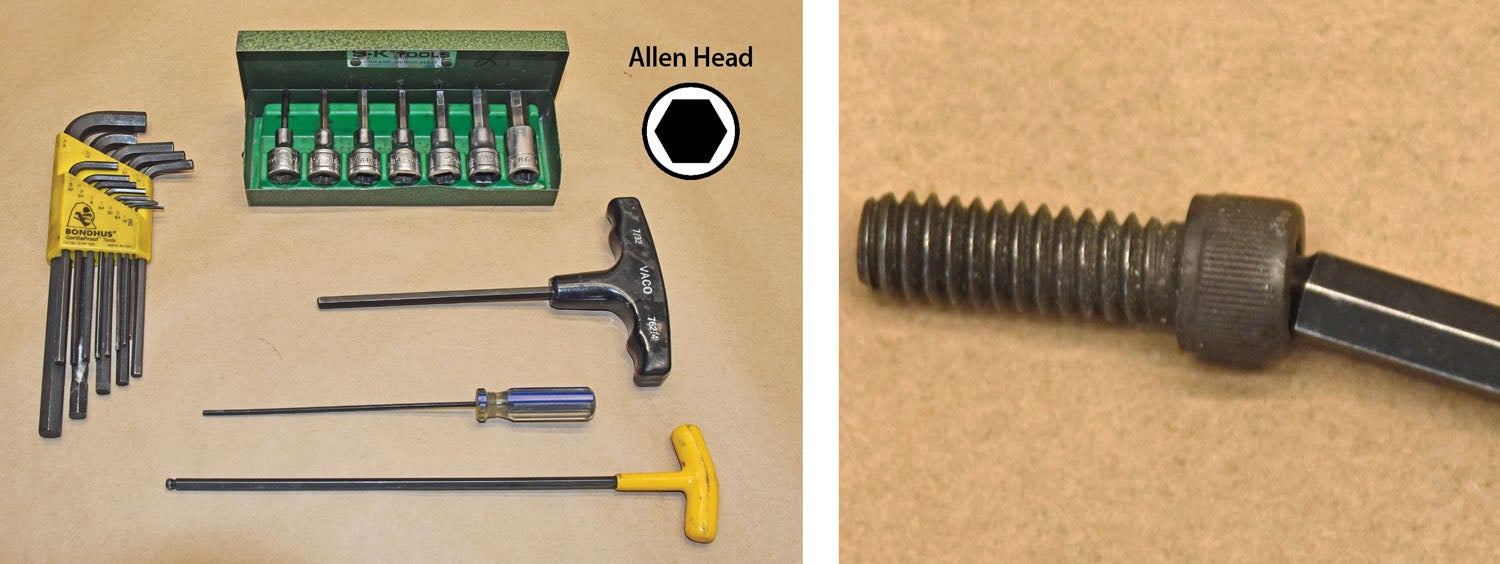
Hex Key Screwdriver or Allen Wrench
You may not think of Allen wrenches as screwdrivers, but they are used to tighten and loosen socket-head cap screws. They come in the familiar L-style, T-handle style or in sockets for various-sized ratchets. Most mechanics will want a set of Allen wrenches in metric and SAE sizes for whatever task may come up. They are not expensive, so this will likely be a good investment. One size I like to keep handy is 3/32-inch, which is used to remove most avionics from instrument panels.
There is a special type of Allen wrench that has a ball end. It will tolerate a great deal of misalignment, making it very handy in certain situations. One such example is the Lycoming fuel pump, where perfect tool alignment is impossible. Just be careful with the ball-end wrench; it has a smaller contact area inside the hex head and, therefore, can damage the fastener if too much torque is applied. This is especially true where the fastener has already been damaged.
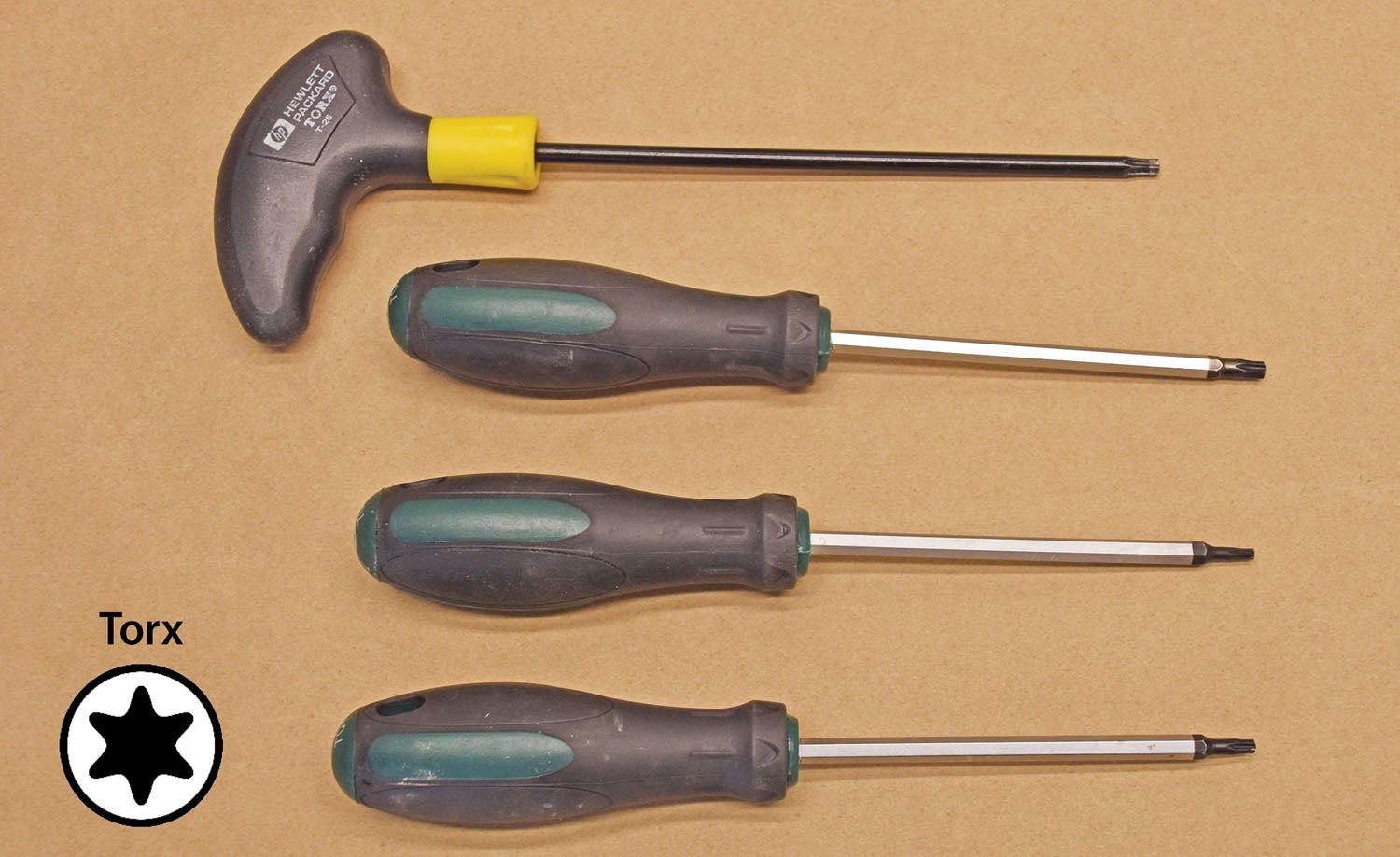
An advantage of the Allen wrench is it is unlikely to damage the screw when tightening, unlike flat-blade or Phillips screwdrivers.
Torx Screwdrivers
Since their advent in 1967, Torx screws and screwdrivers have become more popular in many industrial applications but have not taken hold in aviation. Their great advantage is that they do not slip and provide even better grip than Allen screwdrivers, allowing higher torque for tightening. They are particularly well suited to power drivers. However, power drivers need to have their torque setting limited to avoid breaking screws.
Since these screws require a special tool for installation and removal, they offer a degree of tamper resistance. The flip side of this is that if you run into a Torx screw and do not have the correct screwdriver you will really be stuck. You should probably invest in a basic set of Torx drivers just so you won’t be frustrated when you run into a Torx screw in the future. Finally, there are specific Torx fasteners designed for tamper resistance with a raised point in the middle of the recess. You’ll need a special tool to remove this fastener.

Power Screwdrivers
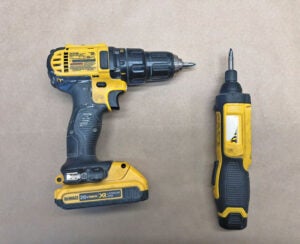
Most of the major tool companies make cordless electric screwdrivers. The most popular model is made by DeWalt and costs about $80. It has interchangeable bits to work with most common types and sizes of screws. Its shortcoming is that maximum torque cannot be preset. For about $70-100 more, Milwaukee and Makita, among others, make units that provide more maximum torque and adjustable maximum torque settings. Many drills also work well as electric screwdrivers, but they are more cumbersome to use in tight places. Their big advantages are longer battery life between charges and greater maximum torque.
All power screwdrivers have the same basic limitation as their manual counterparts in that they need to be in good alignment with the screw to avoid damaging the screw head or slipping and damaging other parts. Power screwdrivers tend to accentuate this problem with their speed and power.
Screw Torque
For most people, the torque setting for a screw is “good and tight” with no idea what that really means. Phillips screws tend to resist overtightening with their built-in cam action that tends to push the screwdriver out of the slot when overtightening. However, determined effort can overcome this feature.
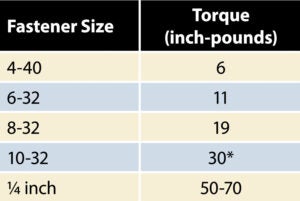
* Some references show a lower torque range of 20-25 inch-pounds.
It may come as a surprise but there are recommended torque settings for screws of various sizes just as there are for nuts and bolts. Most people do not have torque screwdrivers, but they are commonly used by jewelers, gunsmiths, and bicycle mechanics. Most aviation mechanics will not have a torque screwdriver, nor do they really need one in most cases, but an awareness of torque is required.
A cordless electric drill can produce more than 1000 inch-pounds of torque. As a point of reference, an AN3 bolt or 10-32 screw only requires about 30 inch-pounds of torque to properly tighten it. In practical terms, that means that you really need to dial down the maximum torque when using your drill as a power screwdriver. The obvious reason is to reduce the chance of over-torquing the screw but also to avoid damaging the screw slot, which is much more likely.
A review of various internet sources for screw torque settings yielded a range of results. Here I have put together a table of the averages of those numbers for stainless steel screws. These numbers are for dry threads.
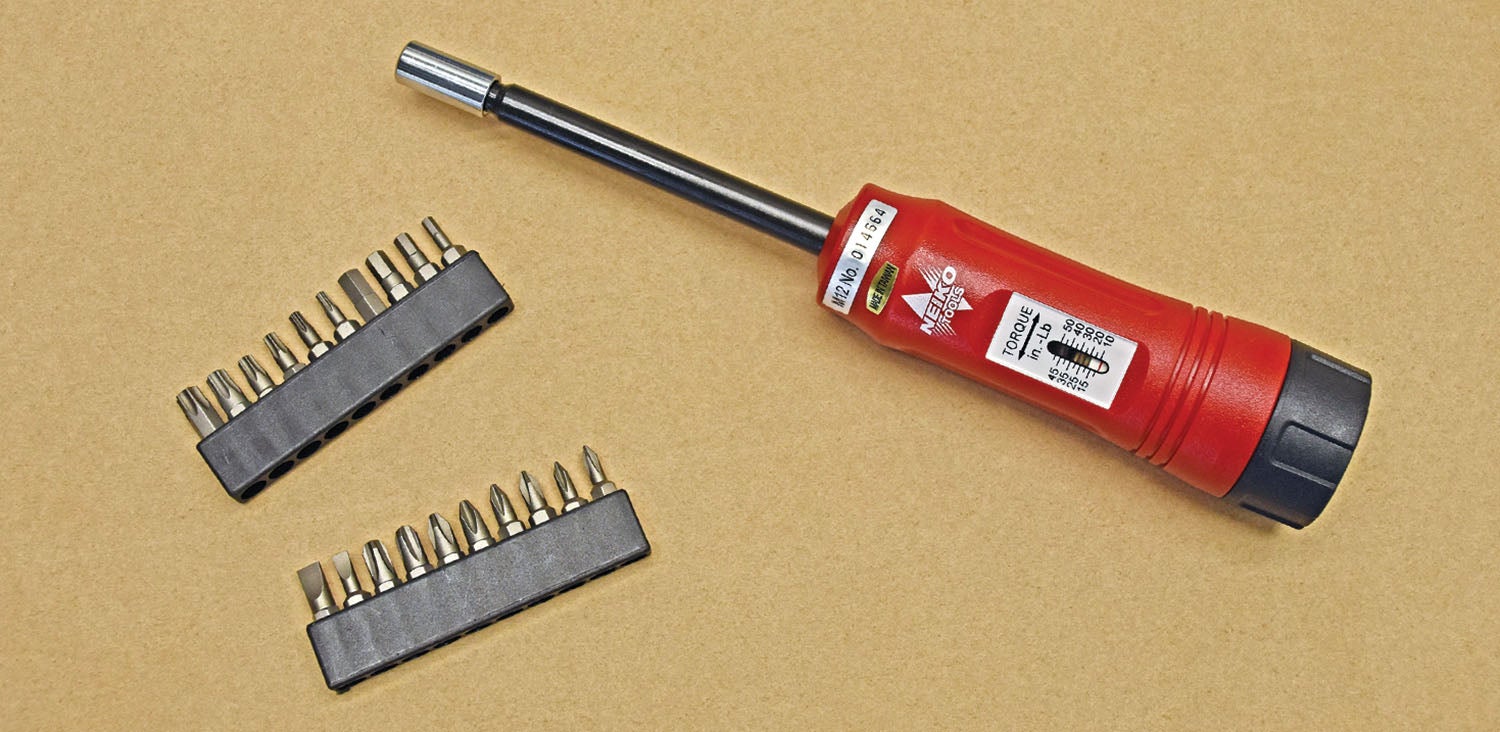
Non-Standard Uses for Screwdrivers
In the medical world, the term “off-label use” is applied to any use of a drug or medical device that is not on the FDA-approved list of uses. Screwdrivers, especially flat-blade screwdrivers, seem to have many off-label uses. Some of these uses are fine, but others could be better performed with a different tool.
A screwdriver can be used as a scraper, but an actual scraper does a better job and is less likely to damage the part being scraped. It can also be used as a punch, but a punch does a better and safer job and should be readily available in your toolbox. I have used a very small Phillips screwdriver as an alignment tool, even as I must admit that the properly sized punch is probably a better choice. A flat-blade screwdriver can also be used as a pry bar, and there is often no good alternative tool available.
Using a screwdriver for a tire bead breaker is a really bad idea. That is a great way to damage a wheel or put a hole in a tube. Another bad idea is using a screwdriver for an electrical conductor to jump across hot terminals. I used to start tractors that way when I couldn’t find the key. It was a bad idea then, and it still is.
Repairing Screwdrivers
If a screwdriver has a broken handle, it should be replaced. However, if the blade has been damaged, it is often possible to repair it by grinding away the damaged metal and restoring it to its original shape. Flat-blade screwdrivers are easily repaired with a grinding wheel or bench sander. Just be careful not to overheat the metal, which will be indicated by the metal turning blue.
Phillips screwdrivers can similarly be repaired but be sure to match the bluntness of the new point with a good screwdriver of the same size. Phillips screwdrivers do not have sharp points. A #1 Phillips has what they call a blunt point. The larger sizes have a somewhat squared-off end, depending on the size. The screwdriver will not work well if the point has not been properly restored.
Hex and Torx screwdrivers may be restored by grinding off the damaged end, depending on how extensive the damage is.
Take care of your screwdrivers and use the proper type and size for the job at hand. Do not abuse them by using them for jobs that are better done with other tools. Treat them right, and they will serve you well for many years.














Odd. The article missed the square-hole Robertson screw which has been around for a century. Ford used it on Model-T’s and it is still popular in many places.